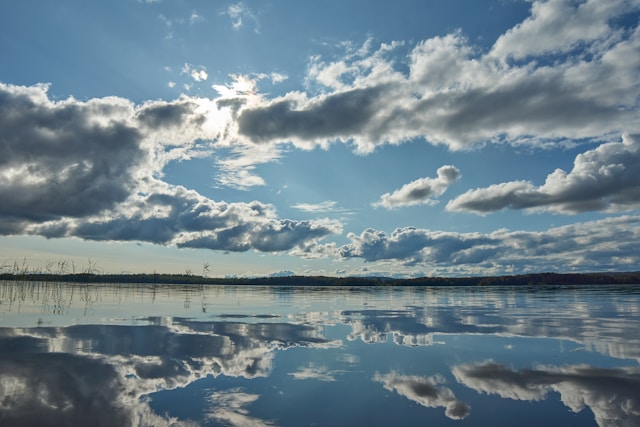Atmospheric pressure, commonly referred to as air pressure, embodies the force exerted by the Earth’s atmosphere upon objects beneath it. It is quantified in millibars (mb), with an average value of 1013.25 mb at sea level. The atmosphere consists of a blend of gases, predominantly nitrogen (78%) and oxygen (21%), alongside trace amounts of argon and carbon dioxide.
Alterations in air pressure frequently indicate forthcoming weather modifications. This is due to the pivotal role played by air pressure in influencing weather systems and phenomena.
Key Factors Influencing Air Pressure
| Factors | Influence on Air Pressure |
|---|---|
| Altitude | As altitude increases, the amount of air above decreases, resulting in lower air pressure. The weight of the air column above a particular point decreases with altitude, leading to a decrease in air pressure. Mountaineers may experience difficulty breathing at high altitudes due to the lower air pressure. |
| Temperature | Temperature has a direct impact on air pressure. When air is heated, its molecules gain energy and move faster, causing the air to expand. As a result, warm air becomes less dense and rises, reducing the air pressure near the ground. Conversely, when air cools, its molecules slow down, causing the air to contract. Cold air is denser and sinks, increasing the air pressure at lower levels. |
| Humidity | Humidity, or the amount of water vapor present in the air, can also influence air pressure. Water vapor is lighter than dry air, which means that moist air is less dense. Consequently, humid air tends to decrease air pressure. Conversely, dry air with lower moisture content is denser and results in higher air pressure. |
These factors interact with one another and are responsible for the complex variations in air pressure observed across different locations and weather conditions. Understanding these influences is essential for meteorologists, pilots, and scientists studying atmospheric dynamics.
How Air Pressure Shapes Weather Patterns
Air pressure systems play a pivotal role in our weather. These systems are categorized as “high pressure” and “low pressure,” which relate directly to the state of the weather.
High-Pressure Systems
High-pressure systems, referred to as anticyclones, represent atmospheric areas with elevated air pressure in contrast to their surroundings. These systems exhibit descending air movements, which give rise to distinctive weather phenomena and circumstances. Generally, high-pressure systems are accompanied by unclouded skies and tranquil weather owing to the downward motion of the air. The descending air undergoes compression, leading to warming and impeding the development of clouds and precipitation. Consequently, high-pressure systems frequently herald favorable weather conditions.
Characteristics of High-Pressure Systems:
- Clear, calm weather: High-pressure systems commonly bring about clear skies, exhibiting minimal cloud cover. The descending air suppresses cloud formation and diminishes the likelihood of precipitation. As a result, these systems are typically associated with sunny and dry weather conditions;
- Lower humidity: In high-pressure systems, the descending air undergoes compression, causing a decrease in moisture content. As the air descends, its ability to retain moisture expands, leading to reduced relative humidity. These systems generally display diminished atmospheric moisture levels, resulting in the dry and pleasant weather commonly linked to high pressure;
- Cool temperatures in winter, warm in summer: During the winter season, high-pressure systems are frequently marked by cooler temperatures. The descending air transports colder air from higher altitudes to the surface, leading to a drop in temperature and the prevalence of cooler conditions. In contrast, during summer, high-pressure systems can bring about warmer temperatures. As the sinking air compresses and undergoes heating, it facilitates the formation of warmer weather patterns.
It is essential to note that high-pressure systems exhibit a clockwise circulation in the Northern Hemisphere and a counterclockwise circulation in the Southern Hemisphere, influenced by the Coriolis effect.
Low-Pressure Systems
Low-pressure systems, commonly known as cyclones, denote atmospheric regions with comparatively lower air pressure than their surroundings. These systems are characterized by upward air movements, which generate unique weather patterns and conditions. Typically, low-pressure systems are associated with cloudy skies and precipitation, as the ascending air cools and condenses, leading to the formation of clouds and unsettled weather. In the Northern Hemisphere, low-pressure systems circulate counterclockwise, whereas in the Southern Hemisphere, they circulate clockwise, influenced by the Coriolis effect.
Characteristics of Low-Pressure Systems:
- Cloudy skies and precipitation: Low-pressure systems are frequently accompanied by cloudy skies attributed to the upward motion of air and the subsequent condensation of moisture. As the air ascends and cools, the water vapor it contains condenses, giving rise to cloud formation and increasing the chances of precipitation. Consequently, low-pressure systems are correlated with unsettled weather conditions such as rain, snow, or thunderstorms;
- Higher humidity: As a result of the ascending air and condensation, low-pressure systems typically exhibit elevated levels of humidity. The upward movement of air facilitates the retention of moisture, causing a rise in relative humidity. Consequently, low-pressure systems are commonly linked to a more humid atmosphere when compared to high-pressure systems;
- Warmer temperatures in winter, cooler in summer: During the winter season, low-pressure systems often contribute to warmer temperatures. The ascending air within these systems has the ability to transport warmer air from lower latitudes to higher latitudes, leading to milder conditions. On the other hand, in the summer season, low-pressure systems can bring cooler temperatures. The rising air undergoes adiabatic cooling, impeding the surface from heating up.
Barometric Pressure Changes and Weather Prediction

Barometers are devices specifically created to gauge atmospheric pressure, a crucial parameter for predicting weather conditions. By monitoring fluctuations in barometric readings, meteorologists and weather enthusiasts can acquire valuable understanding of impending weather changes and trends.
Falling Pressure
Low-pressure systems exhibit a distinctive feature of having atmospheric pressure lower than the surrounding regions. These systems arise when air ascends and spreads apart, resulting in a vertical airflow pattern. As the air rises, it undergoes cooling and condensation, giving rise to cloud formation and the possibility of precipitation. The decrease in barometric pressure signifies the upward motion of air within the low-pressure system.
Here is an elaborate breakdown of the impacts and distinguishing traits associated with declining pressure:
- Weather Conditions:
- Unsettled weather: A decrease in pressure often indicates the impending arrival of a low-pressure system, which is commonly linked to unstable weather conditions. Such conditions can encompass rainfall, storms, or even snow, depending on the prevailing temperature;
- Warmer temperatures: Low-pressure systems are frequently accompanied by elevated temperatures due to the rising air within the system, which traps and retains heat, resulting in a general warming effect.
- Moisture and Cloud Formation:
- Condensation: As the air ascends within the low-pressure system, it expands and undergoes cooling. This cooling process causes the moisture in the air to condense, leading to the formation of clouds;
- Increased humidity: The rapid decrease in barometric pressure signifies the motion of air and the consequent condensation of moisture. This phenomenon results in heightened humidity in the atmosphere.
- Precipitation:
- Likelihood of precipitation: The convergence of ascending air, cloud formation, and heightened humidity within a low-pressure system establishes favorable circumstances for precipitation. The specific type of precipitation (such as rain, storms, or snow) is contingent upon the prevailing temperature and other localized factors.
Rising Pressure
A rapid increase in barometric pressure signifies the onset of a high-pressure system. High-pressure systems are defined by having higher atmospheric pressure in comparison to the surrounding areas. These systems tend to bring about more stable weather conditions, often resulting in clearer skies and tranquil weather patterns.
\Here is a comprehensive breakdown of the impacts and distinguishing features associated with rising pressure:
- Weather Conditions:
- Stable weather: Increasing pressure is commonly linked to high-pressure systems, which typically herald more stable weather conditions. These conditions encompass clear skies, diminished cloud cover, and reduced likelihood of precipitation;
- Calmer weather: High-pressure systems generally bring about calmer atmospheric conditions, characterized by decreased wind speeds and less turbulent weather patterns.
- Air Motion and Compression:
- Sinking motion: The rise in barometric pressure signifies the downward movement of air within the high-pressure system. As the air descends, it undergoes warming and compression, which hinders the formation of clouds;
- Inhibition of cloud formation: The downward motion of air within a high-pressure system restrains the vertical movement and condensation of moisture. Consequently, there is a reduction in cloud formation, resulting in clearer skies.
- Precipitation:
- Reduced chances of precipitation: The descending air and compression within a high-pressure system diminish the chances of precipitation. The drier air and absence of upward airflow restrict the conditions required for substantial precipitation.
Conclusion
Air pressure plays a vital role in shaping the weather patterns of our planet. Gaining insights into its dynamics, including the workings of high and low-pressure systems or the use of barometric pressure changes for weather forecasting, enables us to anticipate and prepare for different weather conditions more effectively. Although we may not often contemplate it, the unseen pressure exerted by the air surrounding us is an enduring and influential force in our day-to-day encounters with weather.
FAQs
As we climb to higher altitudes, the quantity of atmospheric mass above us decreases, resulting in reduced exerted pressure. Consequently, air pressure gradually diminishes with increasing altitude.
Certain individuals may encounter alterations in their physical well-being when there are abrupt shifts in weather, often related to fluctuations in air pressure. Symptoms such as headaches, dizziness, or joint pain can be experienced, but it’s important to note that these effects can vary significantly from person to person.
Monitoring changes in air pressure can serve as a valuable tool for predicting short-term weather shifts. An increase in pressure generally suggests an improvement in weather conditions, while a decrease in pressure can indicate a deterioration in weather conditions.
Air pressure experiences changes as a result of fluctuations in temperature, altitude, and humidity. Additionally, the movement of air masses, including high and low-pressure systems, can also cause alterations in air pressure within a particular location.
A pressure gradient refers to the change in air pressure over a specific distance. This pressure difference is responsible for the movement of air, as it flows from regions of high pressure to areas of low pressure. The strength of the wind is directly influenced by the magnitude of the pressure gradient – the larger the gradient, the stronger the wind.


